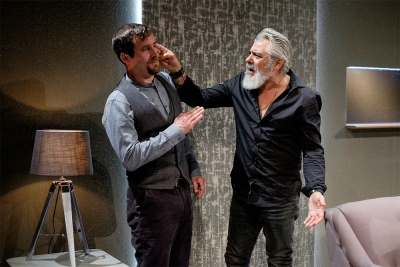Theatre
Tessa Ensler is a criminal lawyer in her thirties. Alone on a minimalist stage, in a black suit and a crisp white shirt, she begins by narrating in the present tense a court drama about an unspecified crime. Narcissistically, she considers herself the star rather than the defendant whom she represents ...
... (read more)Belgian theatre director Ivo Van Hove has an appetite for bringing cinema to the stage. As artistic director of the Toneelgroep Amsterdam since 2001, he has directed stage adaptations of three Ingmar Bergman films, made work inspired by Pier Paolo Pasolini and Michelangelo Antonioni, and staged a version of John Cassavetes’ 1977 drama ...
... (read more)An explicitly racist advertisement for a skin-whitening treatment, the eponymous White Pearl cream, has gone viral. The pastel offices of ClearDay – the Singaporean cosmetics company behind the ad – become the backdrop for a disastrous attempt at damage control. Presided over by manager Priya Singh ...
... (read more)Louis Nowra’s much-loved play Così is often held up as the archetypal great Australian comedy, a larrikin farce in the vein of Michael Frayn’s Noises Off (1982). But as the years roll by and the play’s sensitivities diverge from contemporary standards, it increasingly seems to share more in common with Shakespeare’s ‘problem plays’ ...
... (read more)Elizabeth Taylor played Maggie to Paul Newman’s Brick in Richard Brooks’s 1958 film adaptation of Tennessee Williams’s Cat on a Hot Tin Roof; a more perfect sexual promise left unfulfilled was never committed to celluloid. But if you want truly pyrotechnical sexual chemistry, it’s hard to look past Taylor’s onscreen work with her real-life husband Richard Burton ...
... (read more)There are few really good plays or films about writers. Our craft, unlike those of painters or musicians, does not seem to lend itself to the visual or aural mediums. There is nothing to look at, and much less to hear. And yet the plays and films continue to be made. Writers, and writing we suppose, are important, even if we have little idea how to ...
... (read more)Billy Pilgrim has come unstuck in time, and while time travel has its drawbacks for the protagonist of Slaughterhouse Five, it may be preferable to being stuck in this interminable adaptation of Kurt Vonnegut’s famous 1969 novel. Monash University Student Theatre’s (MUST) adaptation of Kurt Vonnegut’s Slaughterhouse-Five was ...
... (read more)With impeccable timing, the week the National Science Foundation published the first picture of a black hole, Sydney Theatre Company opened its production of Mosquitoes, Lucy Kirkwood’s exploration of the gulf between supposedly rational scientific knowledge and the vagaries of the human heart. Kirkwood has never been afraid of confronting big themes ...
... (read more)Ulster American (Traverse Theatre Company/Adelaide Festival) ★★★★★
In the program note for his most recent play, Belfast playwright David Ireland claims that ‘he became a playwright after being unemployed and unemployable as an actor for three years, despite having trained as an actor for three years at the Royal Scottish Academy of Music and Drama ...
... (read more)The plays of William Shakespeare have the dubious honour of being the most reinvented, reimagined, dressed-up, dumbed-down, and generally meddled-with works ever staged. To a less prolific extent, the same is true of the Classical canon of ancient Greece. In unskilled hands, countless injustices have been ...
... (read more)










